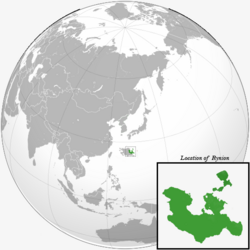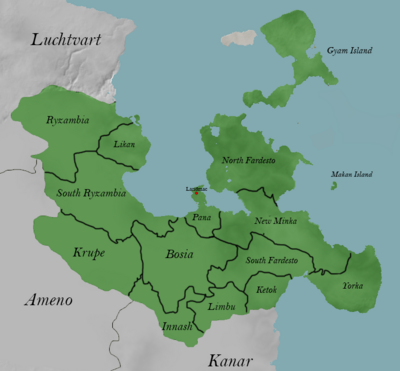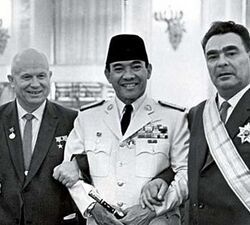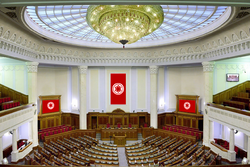Rynion: Difference between revisions
| Line 205: | Line 205: | ||
=== Political Divisons === | === Political Divisons === | ||
[[File:RynionMap.png| | [[File:RynionMap.png|400px|thumb|left|<center>Provinces of [[Rynion]]]] </center> | ||
Rynion consists of 15 provinces, each with their own governors and | <big>Rynion consists of 15 provinces, each with their own governors and judiciary. Governors are tasked with maintaining order in the provisional levels and reports everything during NPA meetings .They are elected by the people of their corresponding province. The provisional government has It's own judiciary called the Provisional Court. The Provisional Court have the authority to judge or adjudicate legal disputes between parties and carry out the administration of justice in civil, criminal, and administrative matters in accordance with the rule of law. | ||
Legislature of each provinces are regulated by the NPA. Each governor can propose a law of which will apply to their corresponding province.</big> | |||
The Province of Pana has a Special Status as a result of having the nation's capital. Pana The island province of Gyam and Makan are Special Administrative Provinces (SAP). They have their own legislative body who are4 headed by a chief executive chosen by the NPA | |||
== Economy == | == Economy == | ||
Revision as of 14:30, 10 July 2019
People's Republic of Rynion Porma Reispaublik Rynaion | |
|---|---|
| Motto: "We Who Were Nothing Shall be All!" | |
| Anthem: "When Tomorrow Comes!" | |
 Location of Rynion | |
| Capital | Landamac |
| Official languages | English |
| Recognised national languages | Issadian |
| Recognised regional languages | Chinese,Japanese,Arabic, and Malay |
| Demonym(s) | Rynionian (Single) Rynionians (Plural) |
| Government | Multi-Party Democratic Socialist Republic |
| Legislature | National People's Assembly |
| Establishment History | |
• Rynai Tribes | 4500 BC |
• Nyancipe Empire | 13th Century |
• British Colonization | 1817 |
• Declaration of Independence | March 3rd 1919 |
• Japanese invasion | February 1942 |
• FSN Annexation of Rynion | December 18th 1951 |
• Independence from FSN | August 5th 1980 |
| Population | |
• 2019 estimate | 131 million |
| GDP (nominal) | 2019 estimate |
• Total | 1,481,420 |
| Gini | 47.79 high |
| HDI | 0.650 medium |
| Currency | Rynionian Ruan (RYR) |
| Time zone | +10 GMT |
| Date format | dd-mm-yyyy |
| Driving side | left |
| Internet TLD | .ry |
Rynion, officially The People's Republic of Rynion is a nation in Nyancipe Island, Southeast Asia, located between Taiwan and the Pacific Ocean. Rynion is a Multi-Party Democratic Socialist Republic with a partially elected-legislature and has a president as the head of state. It has 15 provinces.The country shares land borders with Luchtvart,Ameno, and Canar.Despite its large population and densely populated regions, Rynion has vast areas of wilderness that support a high level of biodiversity.
The history of Rynion has been influenced by foreign powers drawn to its natural resources and soil fertility. It has been an important region for trade since at least the 13th century when the Nyancipe Empire traded with entities from mainland China and Mainland Asia. Muslim traders and Sufi scholars brought Islam. The British Empire conquered Nyancipe and brought Christianity. Rynion officially gained independence after a partition drafted by the British in 1919. Rynion was absorbed by the Socialist Federation of Nyancipe in 1950. The SFN forged a strong alliance in the Eastern Bloc and the Soviet Union until its collapse in the 1980s.
Rynion consists of three main native ethnic and linguistic groups, with the largest—and politically dominant—ethnic group being the Rynaians. A shared identity has developed, defined by a national language, ethnic similiarity, and a history of colonialism and rebellion against it. Rynion's national motto,"We Who Were Nothing Shall Be All", articulates the spirit of their people who oppose against frequent intervention by foreign powers that shape the country throughout its history . Rynion's economy is fairly diversified and led by the Beef-Based Agriculture industry, with major contributions from Information Technology, Uranium Mining, and Tourism. State-owned companies are common. The country has abundant natural resources like oil and natural gas, tin, copper, and gold. Agriculture mainly produces oats, palm oil, rice, tea, and coffee. Rynion major trading partners are Japan, South Korea, ASEAN Countries Russia,and China. Rynion is a member of several multilateral organisations, including the UN, WTO, Asia-Pacific Economic Cooperation, and East Asia Summit.
Etymology
The word "Rynion" derives from the Welsh word for hulled oats. The term was used by British settlers in the mid 18th century to designate the most fertile part of Nyancipe Island and its native tribes on the area refered to as "Rynionians" or the "Rynai Tribe". The word "Rynion" wasn’t widely used until the British divided the island into 7 republics and one of them was named Rynion. During the SFN, Rynion was widely known by the rest of the world as the agricultural powerhouse of the SFN.
However, the island itself was named after the longest river in Asia by Chinese explorers. It was named "Yangtzi" but later called "Nyancipe" due to different language between them and the native islanders. "Nyancipe" was widely known during the Nyancipe Empire.
History
Early History
Humans arrived from Asia through a landbridge approximately between 60,000 and 100,000 years ago. Skeletal remains suggest that Homo Sapiens and Homo Erectus coexist in Nyancipe. Around 5000 BC, inhabitants of the island developed agriculture. The perfect climate of the island makes it ideal for the cultivation of various plants including wheat, corn, and oats
Tribal Eras
As the inhabitants of the Island develop, many tribal communities emerge and rule small portions of land scattered throughout the island. The Kicens emerge on the eastern parts of Nyancipe, while Rynians to the west and Canarians to the south. Tribal communities typically consist of a few houses, a large farmland, and storage huts. Although the full extents of their territories are unknown, archeological evidence from 4500 BC suggests that the current territories of Macra, Kicen, and Luchtvart are far less populous than any other part of the island. Modern-day Rynion was home to the Rynians which were the largest tribal community in the area.
Communities make it easier for technology to advance. In 3200 BC, they began to develop sophisticated writing systems and advanced stone tools and weapons. Wars are fought frequently by tribal communities over food and territory claiming dozens of lives.
Unification and Formation of the Nyancipe Empire
From the 13th century until the 17th century, the island was unified under the Nyancipe Empire. The Nyancipe Empire was formed after a massive 10-year war between three large tribal communities of Canari, Rynai, and Kicens that claimed the lives of almost 7.000 people. In the early years of the war, the Canarians dominate eastern Nyancipe after a large battle with Kicens claiming 2.000 lives, severely weakens the Canarians. Rynaians and Kicens fought for territories on modern day Ameno. After 4 years of stalemate, Rynaians and Kicens agreed on a peace treaty and merged their territory. The joint Canari-Rynai tribes fought back against the Canarians and after a decisive victory at the battle of Harkuz, the Canarians offered to join the alliance and establish a newly unified empire with the capital in Kamya.
The Nyancipe trades with various empires across the globe from the Ottoman Empire to the Qing Dynasty and also many other kingdoms in Asia. Most of their exports are agricultural products, fish and minerals. Influence from this era can be seen in the modern day as religion, predominantly Islam and Confucianism, as well as languages like Arabic and Malay.
Fall of Nyancipe Empire and British Colonization
The British Empire arrived in Nyancipe in the late 17th century. Britain declares war against the Nyancipe Empire in the early 18th century. The war was fought for 11 years, millions of Nyancipians died which severely reduced the population and as much as 1.000 British soldiers. The war finally ended with the collapse of the Nyancipe Empire in 1817. Britain began colonizing and settling on the island. They enslaved the locals into working on fields and mines throughout the island. Millions of Nyancipian suffered under colonial rule. Britain’s colonization of Nyancipe brought Christianity and English to the island.
World War 1 and Nyancipian Partition
After WW1, The British Empire was in serious debt and began drawing plans of a Nyancipian Partition. They divided the island into 7 independent republics according to the different ethnic groups; Kicen, Luchtvart, Dovia, Macra, Rynion, Ameno, and Kanar. They implemented the plan on March 3rd, 1919 which resulted in a mass displacement of people moving to their ethnic states. The first Rynionian constitution was drafted on July 17th and came into effect a few months later in October. The first presidential election on New Year’s Eve 1920 elected Karzai Mik as President.
Japanese Invasion during World War 2
In February 1942, Imperial Japan launched a full-scale invasion on Nyancipe. Rynion and its allies (6 other countries on the island) formed a Joint Military called the Markidan, consisting of 60.000 troops to counter the Japanese invasion. The first campaign against the Japanese took place in the ports of Northern Luchtvart and Kicen of which thousands of Japanese and Markidan casualties. Japanese forces came out victorious after a month of fighting. Japanese forces steam-rolled through Nyancipe taking large parts of the Island within 3 months. The last Markidan forces were surrounded in Rynion and surrendered on November 21st, 1942. Nyancipe was under Japanese control until 1945 when the US liberated the island and briefly occupying it.
SFN and the Cold War
Seeing the success of the Soviet Union during WW2, Luchtvart, Dovia, Macra, and Kicen merged and formed the Socialist Federation of Nyancipe (SFN) on February 6th, 1949. For the next 10 months, war broke out between the new SFN and the surrounding states on the island including Rynion. The war resulted in Socialist victory and the whole island fell into socialism. In 18th of December, the Socialist Party of Nyancipe (SPN) was founded by Akdu Kivan. The socialist party started purging political opposition in February 1950. All who dare to speak out against their rule was executed, deported, or imprisoned. The collectivization of farmlands and industries started in June the same year. Millions of people are forced to work in fields and factories all across the island with minimum rations and pay. By 1952, all industries within the Republics of the SSN become state-owned.
During 1953 – 1962, the SFN establish close ties with the Soviet Union and China. The USSR offered the Federation to join the Warsaw Pact. They refused but joined the Eastern bloc as a close Soviet ally. Soviet intelligence officers are often stationed in Nyancipe as a base of operations for their espionage missions in Japan, South Korea, and Southeast Asia.
During the height of the Vietnam War, Socialist Nyancipe aided the North Vietnamese by supplying weapons, ammunition, and food. Although no records exist on how much aid was going into North Vietnam, experts estimate that around 10% of North Vietnamese weapons and ammunition, as well as 16% of rations, come from Socialist Nyancipe. Soviet intervention in the Middle East and Afghanistan prompted the SFN to increase their military spending and send troops to fight alongside Soviet forces. As of 1980, Socialist Nyancipe sends over 10.000 troops to Afghanistan and military spending accounted for 35% of the national budget.
Fall of SFN
The SFN economy was failing in the 1980s due to overspending in the military. People all across the Federation are starving and angry. With the death of Premier Heinz Ardal, his successor Karvin Lat sought to revitalize the economy by allowing private ownership of businesses and loosening regulations on free speech. The people who had been oppressed for decades took to the streets of the Federation’s capital. The Nationwide revolution against the Federation lasted from 9 June until 10 August 1983.
The revolt began as a student protest, which attracted thousands as they marched through central Harkuz to the Socialist Party Parliament building, calling out on the streets using a van with loudspeakers. A student delegation, entering the radio building to try to broadcast the students' demands, was detained. When the delegation's release was demanded by the protesters outside, they were fired upon from within the building by the Federation’s Security Police (FSP). This was the start of the revolution. As the news spread, disorder and violence erupted throughout the capital.
The revolt spread quickly across Nyancipe, and the government collapsed. Thousands organized into militias, battling the FSP. Pro-Socialist and FSP members were often executed or imprisoned, and former political prisoners were released and armed. A new temporary government formally disbanded SFN establishes the Re-independence of the 7 republics. By 9th of August, fighting had almost stopped, and a sense of normality began to return.
Geography
Government and Politics
Government
Rynionian political system is a multi-party system with 9 political parties competing for seats in the National People’s Assembly. Every political party has a Head of Party and must submit a party member as candidates for a specific political position who will then be elected by the people. The political parties must adhere to the constitution.
The Executive Branch of Rynion is the President and Vice President. Both are elected by the people for a 5-year term. The presidential candidate has to be a Rynionian citizen since his/her birth, who has not willingly become a citizen in another nation, has not betrayed the nation, and is physically and mentally capable of doing the job. The president is also required to be nominated by a Political Party or a coalition of Political Parties.The president has constitutional authority over the government and has the power to name and remove ministers. He or she has the right to propose bills to the NPA, to discuss bills with the NPA to reach an agreement, make government regulations in accordance with laws, and in the case of emergencies has the power to make government regulations in rule of law.
Militarily, the president holds supreme authority over the Rynionian National People's Forces. Diplomatically, the president can only sign treaties, appoint ambassadors, accept ambassadors from other countries, and rehabillitate prisoners. The president has the power to grant pardons but must consider the advice of the NPA. The president also has the final say over chief justice candidates.
The Legislative Branch of Rynion is the National People’s Assembly (NPA). The National People’s Assembly has 500 seats. The NPA is tasked with making laws and appointing political positions. It is headed by the Assembly President. The NPA consists of The President and Vice President, Assembly President, Head of Political Parties and their envoys. The NPA held an annual meeting every October to discuss national issues and appointing new members of the government.
The Judicial Branch of Rynion is the People’s Court. The People’s Court is tasked with interpreting and applying laws that have been passed by the National People's Assembly. The court also has the power to impeach high ranking government officials for treason and other severe illegal activities.
Political Divisons

Rynion consists of 15 provinces, each with their own governors and judiciary. Governors are tasked with maintaining order in the provisional levels and reports everything during NPA meetings .They are elected by the people of their corresponding province. The provisional government has It's own judiciary called the Provisional Court. The Provisional Court have the authority to judge or adjudicate legal disputes between parties and carry out the administration of justice in civil, criminal, and administrative matters in accordance with the rule of law. Legislature of each provinces are regulated by the NPA. Each governor can propose a law of which will apply to their corresponding province.
The Province of Pana has a Special Status as a result of having the nation's capital. Pana The island province of Gyam and Makan are Special Administrative Provinces (SAP). They have their own legislative body who are4 headed by a chief executive chosen by the NPA







